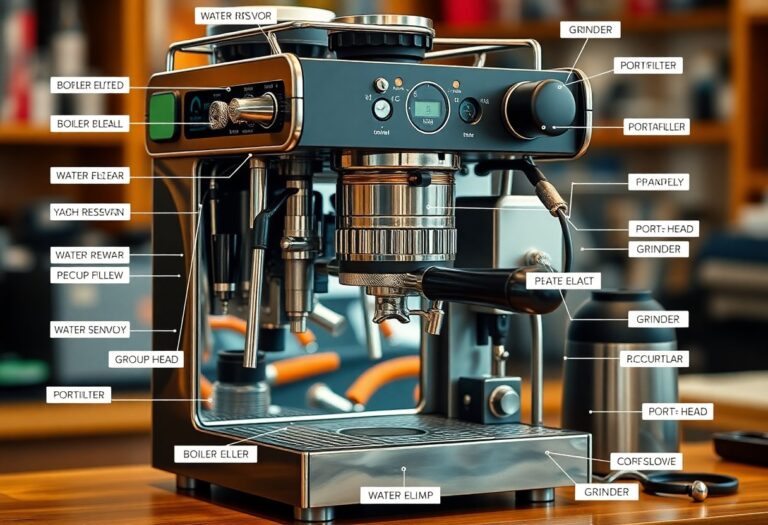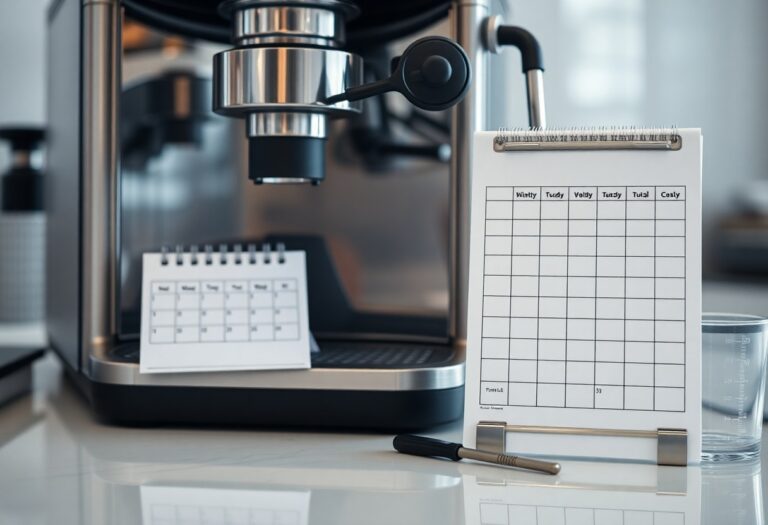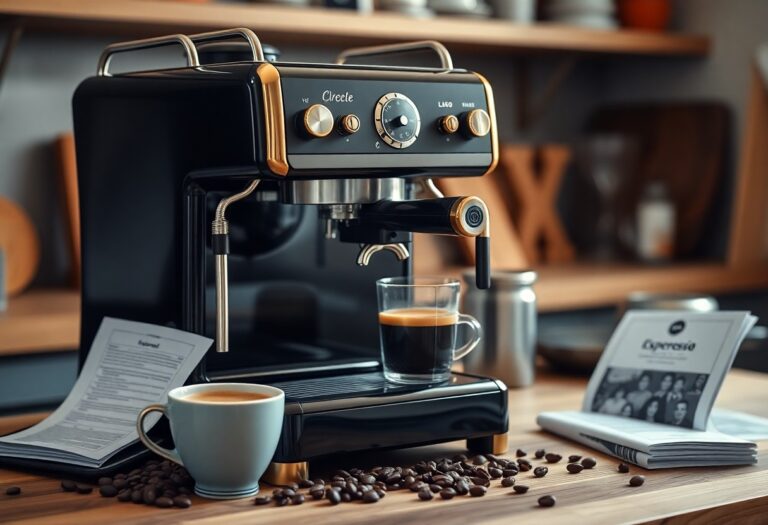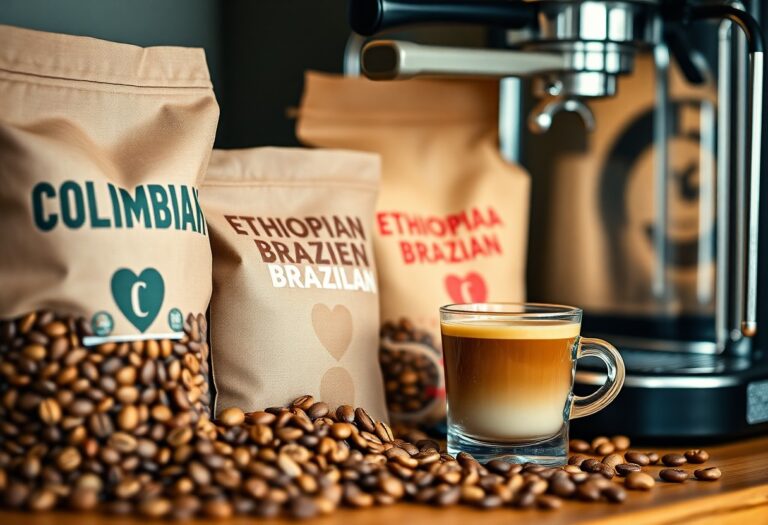What Coffee Grind for a Coffee Machine – Grind Size Guide
Coffee is an art that begins with the perfect grind. The grind size you choose can dramatically affect the flavor and strength of your brew, making it necessary for you to understand how to select the right one for your coffee machine. Whether you’re aiming for a rich espresso or a smooth drip, using the proper grind size can make a significant difference in your cup’s taste. For an in-depth look at various grind sizes, check out this Coffee Grind Chart – The Best Coffee Guide to help you make informed decisions about your coffee experience.
Key Takeaways:
- The grind size significantly affects the extraction and flavor profile of the coffee. A finer grind typically suits espresso machines, while a coarser grind is ideal for methods like French press.
- Different brewing methods require specific grind sizes; for example, drip coffee makers work best with a medium grind, while pour-over methods benefit from a medium-coarse grind.
- Uniformity in grind size is important to ensure even extraction and avoid over or under-extraction of flavors.
- Experimenting with grind sizes can enhance your coffee experience as personal taste preferences vary, and slight adjustments can yield different flavor outcomes.
- Investing in a good grinder can make a significant difference in achieving the desired grind size consistently, therefore improving the overall quality of your coffee.
The Precision of Grind Size: Why It Matters
Precision in grind size directly influences the extraction process during brewing. Each type of coffee machine requires a specific grind to optimize flavor and aroma. A mismatch can lead to under-extraction, resulting in a dull cup, or over-extraction, producing bitterness. The right grind size balances extraction time and surface area, ensuring that you capture the coffee’s full flavor potential. Understanding these nuances equips you to elevate your daily brew from mundane to extraordinary.
The Journey from Bean to Brew
Every coffee experience starts at the bean. After roasting, beans undergo a metamorphosis where grind size becomes a pivotal factor in flavor development. Whether you choose a coarse, medium, or fine grind, the size dictates how quickly water interacts with the coffee. This interaction directly affects the extraction of oils, acids, and sugars, all vital to your cup’s character. The grind you select initiates a journey that embodies the essence of the coffee itself before it even touches your brewing method.
The Impact of Grind Size on Flavor Profile
Your selected grind size alters not only extraction time, but also the overall flavor profile of your brew. When preparing espresso, a fine grind allows for quick extraction, highlighting intense flavors and rich crema. Conversely, a coarse grind for French press permits longer extraction, unveiling smoother, bolder notes with less acidity. Each adjustment in grind size shapes your coffee experience, enhancing or muting flavors like sweet caramel or bright citrus, ultimately guiding you to find your perfect cup.
The grind size significantly affects how water interacts with coffee particles during brewing, and this interaction dictates which flavors are released. For example, a fine grind allows hot water to extract flavors more intensely and quickly, yielding a complex, vibrant cup rich in chocolate and nutty notes. Alternatively, using a coarser grind results in a slower extraction, which may produce a less acidic and mellower brew perfect for sipping leisurely. Experimenting with grind size can unlock a myriad of tastes—from fruity brightness to deep, earthy undertones—and allow you to customize your coffee experience to match your palate. Crafting your perfect cup often means experimenting with different grind sizes to discover which flavors resonate best with you.

Matching Grind Size to Brewing Method
Each coffee brewing method has unique requirements, and understanding how to match your grind size to the specified technique is necessary for extracting the desired flavors. A resource such as The Complete Guide to Grind Size and Coffee Brew Methods can provide a roadmap to help you optimize your brewing experience by selecting the right grind size.
Espresso: The Fine Balance of Fineness
Espresso demands a finely ground coffee to achieve the rich, concentrated flavor you crave. A grind size similar to table salt ensures optimal extraction in the brief brewing time, allowing the high-pressure water to rapidly dissolve the coffee’s complex flavors. Adjusting the grind slightly can dramatically alter the shot’s taste; aim for consistency to hit that perfect balance.
Drip Coffee: Harnessing Medium Grind for Optimal Extraction
For drip coffee makers, a medium grind works best, providing a balanced extraction without bitterness. This grind size resembles granulated sugar, allowing water to flow through your coffee grounds evenly while extracting necessary oils and flavors at an ideal pace.
Medium grind ensures your drip coffee is flavorful without over-extraction, which can lead to undesirable bitterness. When brewed correctly, the uniform particle size of this grind facilitates consistent water flow through the coffee grounds, allowing for even extraction. This results in a harmonious cup that showcases your coffee’s unique flavor profile, maintaining balance and smoothness in each sip.
French Press: The Case for Coarser Cuts
The French Press benefits from a coarser grind to prevent over-extraction and sediment issues. Aim for a grind size similar to breadcrumbs, which allows the coffee to steep correctly while minimizing a gritty texture in your final brew.
A coarser grind in the French Press allows for a slower extraction, emphasizing your coffee’s full-bodied flavors without bitterness. Because the coffee grounds steep in contact with hot water for several minutes, using larger particles ensures a smoother cup. Finely ground coffee can lead to sludge in your brew, so stick with those hearty, coarse cuts to enjoy a clean and robust coffee experience.
Cold Brew: Embracing the Coarse Grind
In the world of cold brew, a very coarse grind is your best bet. A grind similar to that of sea salt ensures optimal flavor extraction over the long steeping process.
By employing a coarse grind for cold brew, you maximize the extraction time while minimizing bitter flavors. The low temperature of the water requires larger particles to extract the coffee’s natural sweetness and acidity gently. The extended brewing period—often 12 to 24 hours—benefits from the coarser grind, leading to a smooth, rich coffee concentrate that you can dilute with water or milk before enjoying.

The Science of Extraction: How Grind Size Influences Brewing
Your coffee experience sharply depends on grind size, as it directly affects the extraction process. When coffee grounds come into contact with water, specific flavors, acids, and oils dissolve more rapidly or slowly based on the grind size you choose. A finer grind increases extraction by exposing more surface area, while a coarser grind leads to a slower, less efficient process. Achieving that sweet balance ensures that your brew will highlight the rich flavors of your coffee beans without resulting in bitter over-extraction or underwhelming watery notes.
Surface Area and Extraction Rates
Grind size influences the surface area of your coffee, which ultimately affects extraction rates. Finer grounds offer a larger surface area, allowing hot water to extract flavors quickly, while coarser grounds have less surface exposure, leading to slower extraction. For example, espresso requires a fine grind to achieve maximum flavor and intensity in a short brewing time, while French press coffee benefits from a coarser grind to maintain a balanced profile without overpowering notes.
Timing: How Grind Size Dictates Brew Time
Brew time is intricately linked to the size of your coffee grounds. Finer grinds brew faster due to greater surface exposure, making them ideal for methods with shorter brew times like espresso, which typically requires about 25-30 seconds. Conversely, coarser grinds need longer brewing times to extract desired flavors. For instance, a French press brew might take around 4 minutes to work its magic. Understanding this relationship helps you control the outcome of your coffee, ensuring it doesn’t turn overly bitter or remain weak and underwhelming.
The right grind size plays a pivotal role in timing your brew correctly. When using a fine grind for a longer brewing method, you risk over-extracting your coffee, resulting in unpleasant bitterness. On the other hand, a coarse grind used in a short brew time may lead to a flat taste with underdeveloped flavors. Finding the perfect balance for your chosen brewing method ensures that you harness the full potential of your coffee beans, creating a cup that’s rich and satisfying.
Common Missteps: Grinding Mistakes to Avoid
Many coffee enthusiasts fall prey to common grinding errors that can ruin their brew. A frequent mistake is using the wrong grind size for your coffee machine, which can lead to bitter or weak coffee. Overlooking the consistency of your grind is another pitfall; variations can impact the extraction process. Lastly, neglecting to adjust your grind size based on your brewing method can prevent you from unlocking the full potential of your beans, resulting in a less-than-satisfying cup of coffee.
Over-Grinding vs. Under-Grinding: Finding the Sweet Spot
Navigating between over-grinding and under-grinding is key to achieving the ideal extraction. Over-ground coffee produces a bitter flavor due to excessive extraction, while under-ground coffee may result in a weak and sour taste. You should aim for a grind size that perfectly balances these extremes, allowing your coffee to express the full range of its flavors. Experimenting with different grind sizes for your preferred brew method can help you hone in on that elusive sweet spot, ensuring a consistently enjoyable coffee experience.
Storage Solutions: Preserving Freshness Post-Grind
Proper storage techniques can significantly impact the freshness and flavor of your coffee post-grind. After grinding, it’s necessary to store your coffee in an airtight container, ideally made of opaque materials to block out light and air. Keeping your ground coffee in a cool, dark place reduces exposure to temperature fluctuations that can lead to rancidity. If you want to maintain peak freshness, use your ground coffee within a week, as flavor deteriorates rapidly.
For optimal storage, consider using vacuum-sealed bags or containers specifically designed for coffee, as these can prevent oxidation. If you want to extend freshness, you could even freeze your coffee grounds, but this should be done in small batches to avoid repeated thawing. By prioritizing air-tight storage and minimal exposure to environmental factors, you can preserve the rich flavors of your coffee, ensuring each cup tastes remarkably fresh and robust.
Crafting Your Perfect Cup: Tips from the Experts
Expert tips can elevate your coffee experience to new heights. Here’s what you need to keep in mind:
- Utilize the correct grind size for your brewing method.
- Invest in a high-quality coffee grinder for consistency.
- Make sure to use freshly roasted beans for optimal flavor.
- Experiment with different water temperatures for enhanced extraction.
Thou will find that small adjustments can lead to significant improvements in your cup.
Experimentation: Finding Your Unique Taste
Finding your ideal coffee flavor often involves experimentation. Don’t hesitate to play around with different grind sizes, brewing times, and coffee-to-water ratios. Even subtle changes impact the final brew, enabling you to discover a taste profile that truly suits your palate. Your unique preferences will evolve over time as you explore various beans and brewing techniques.
Equipment Upgrades: Choosing the Right Grinder
Selecting the right coffee grinder can transform your brewing game. Manual and electric grinders come with diverse features; consider one that offers multiple grind settings to match your preferred brewing method. A burr grinder is often favored for its ability to produce uniform particle sizes, leading to a more consistent extraction. The perfect grinder not only enhances flavor but also makes multi-tasking a breeze.
Investing in a high-performance burr grinder can drastically elevate your coffee-making process. For instance, models like the Baratza Encore offer over 40 grind settings for various brew methods, ensuring you can easily switch from espresso to French press. Starting your coffee-making journey with a quality grinder means you can harness the full potential of your beans, achieving that rich, aromatic cup worth savoring every day. Explore your options and choose one that aligns perfectly with your coffee habits and preferences.
Conclusion
Hence, understanding the right coffee grind size for your coffee machine can significantly enhance your brewing experience. By tailoring the grind size to your specific machine, whether it’s a drip coffee maker, espresso machine, or French press, you can ensure optimal extraction and flavor. Take the time to experiment with various grind sizes, and enjoy the rich, nuanced flavors that a well-crafted cup of coffee can provide. Your choice of grind is the key to unlocking the full potential of your coffee beans.
FAQ
Q: What are the different grind sizes for coffee?
A: Coffee grind sizes typically fall into six categories: Coarse, Medium-Coarse, Medium, Medium-Fine, Fine, and Turkish. Coarse grounds resemble sea salt and are ideal for methods like French press. Medium-coarse is slightly finer and suitable for pour-over or drip machines. Medium grind appears similar to regular sand and is versatile for most drip coffee makers. Medium-fine is more powdery and works well with cone-shaped pour-over devices. Fine grind, akin to table salt, is best for espresso machines. Finally, Turkish coffee requires an extremely fine powder, almost like flour.
Q: How do I determine the right grind size for my coffee maker?
A: The right grind size largely depends on your brewing method. For example, if you’re using a French press, a coarse grind allows for optimal extraction without over-extracting the coffee. For espresso machines, a fine grind maximizes surface area for quick extraction. Understanding your brewing method will help you choose the appropriate grind size for the best flavor profile.
Q: Can the grind size affect the taste of my coffee?
A: Yes, the grind size can significantly influence the taste and aroma of your coffee. A grind that is too fine can lead to over-extraction, making your coffee taste bitter. Conversely, a grind that is too coarse may result in under-extraction, causing the coffee to taste weak or sour. Achieving the right grind size helps ensure a balanced, flavorful cup.
Q: How do I adjust the grind size if my coffee tastes off?
A: If your coffee tastes off, consider adjusting the grind size according to the flavor you experience. If it’s too bitter, switch to a coarser grind. If it tastes weak, try a finer grind. You may also experiment with other variables such as brewing time and water temperature to fine-tune your coffee experience.
Q: Is it necessary to invest in a burr grinder for consistent grind sizes?
A: While not absolutely necessary, investing in a burr grinder is recommended for achieving consistent grind sizes. Burr grinders provide a uniform grind, resulting in even extraction and a better-tasting coffee. Blade grinders can create uneven particles that may lead to inconsistent flavors. If you’re serious about your coffee, a burr grinder is worth the investment.







